“Hanuman Mukhavata” has been added to your cart.
View cart
-
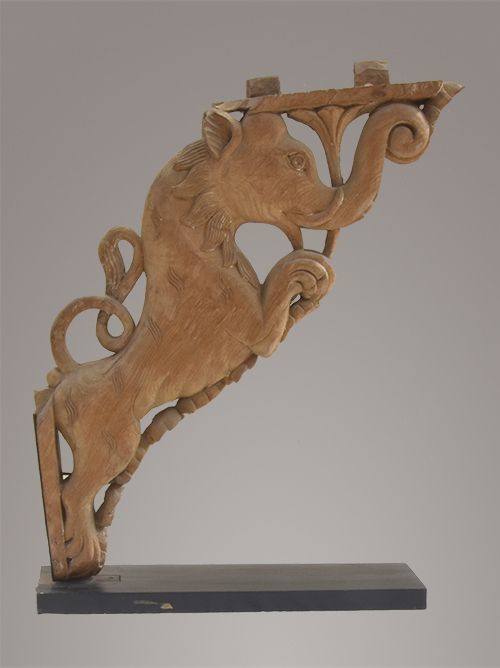
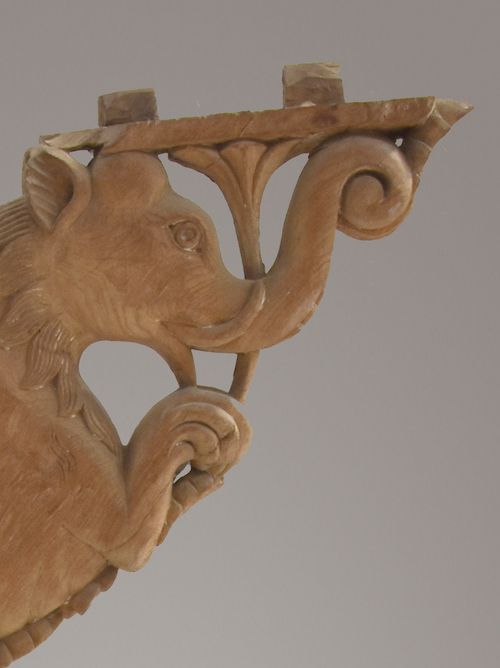
TEAK
c. 1920
The Makara is a mythical aquatic creature that combines the body of a crocodile with the head of a lion and the trunk of an elephant. One of India’s most ancient symbols, harking back more than two thousand years to a time when the natural world was seen as both symbol and reality, and fantastic creatures were invented to express the complexity of nature. The Makara is considered auspicious and purifying by Hindus and related to fertility. he is the vehicle (vahana) of Varuna, god of the waters of heaven and earth, and the emblem of Kama, the god of love.
Sizes (cms): 80 (H) x 62 (W) x 20 (D)
Sizes (inches): 31.4 (H) x 24.4 (W) x 7.9 (D)
-
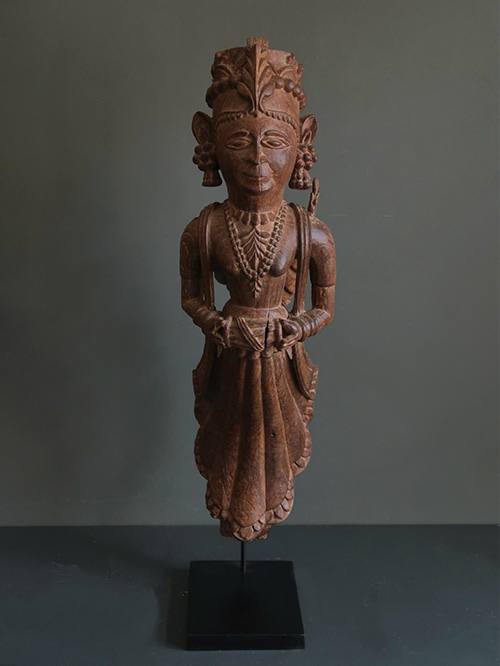

Patan (Gujarat)
Wood
A fine figural strut formed as a crowned celestial musician (Vidyadhara). She holds a small drum and wears a patterned blouse and a flowing pleated skirt standing in a typical curved posture. Her long veil drapes behind her shoulders resembling wings. The appearance of wings on figures is a very old tradition in Indian art. Although seen in many parts of Gujarat the treatment his novel : the robes of the figure turn up at the ends and the veil cross the shoulders and turns into wings.
The ancestral occupation of the Hindu Suthar community, the craft of wood carving was practiced in several districts of Gujarat including Patan, Kadi, Ahmedabad and Nadiad, although the legacy of exquisite wood carving seen in the traditional havelis, mansions, is evident in all the districts of Gujarat. Patan district is renowned for the intricately carved Bohra haveli or mansions at Siddhpur; these structures are characterised by their eclectic use of geometric or floral patterns as well as motifs inspired by European and West Asian decorative elements on the woodwork of the balconies and ceilings.The wooden architecture of Ahmedabad on the other hand, acquires its distinctive aesthetic through the use of patterns borrowed from block printing and textiles.
Size (cms): 72.5(H) x 20(W) x 28(D)
Size (inches): 28.5(H) x 8(W) x 11(D)
-
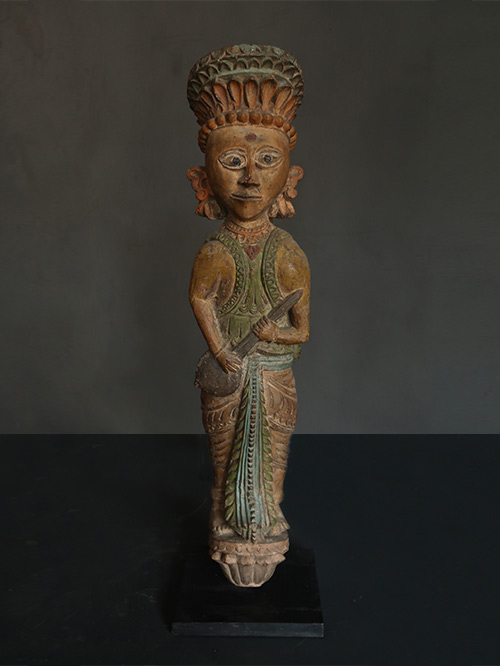

Gujarat (Western India)
Wood with traces of polychrome
An attractive architectural bracket with original colour depicting a figure holding an instrument, possibly a Tanpura. The figure wears a decorated crown and has a stylised face with large ovular eyes pressing into a pointed nose and ears in the shape of swirling foliage. He is dressed in a pleated dhoti and a patterned vest. A stylised stole that is draped across his shoulders, turn into wings that emerge from either end of his body. A tilak is marked on his forehead.
Dwarapalas or ‘door guardians’ are placed at the entrance of every temple, shrine or sacred precinct. Two or four-handed, they sometimes carry in their hands the emblem of the deity enshrined in the sanctuary. Their countenance may sometimes be fierce and occasionally fangs protrude from their mouths. Temples dedicated to goddesses have female guardians – the Dwarapalikas.
Size (cms): 75 (H) x 20 (W) x 19 (D)
Size (inches): 29.5 (H) x 8 (W) x 7.5 (D)
-
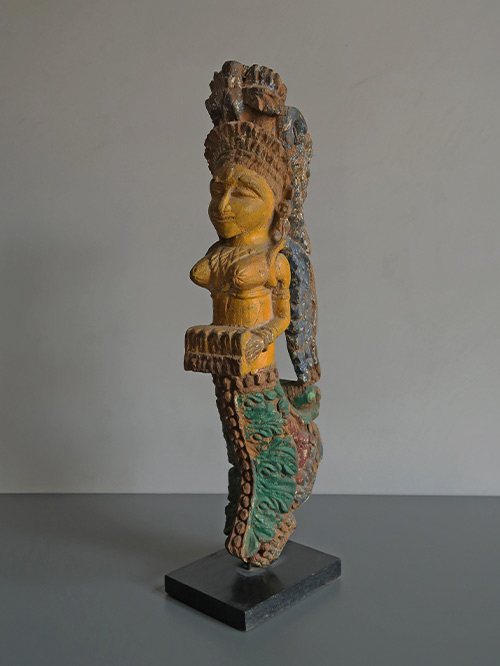
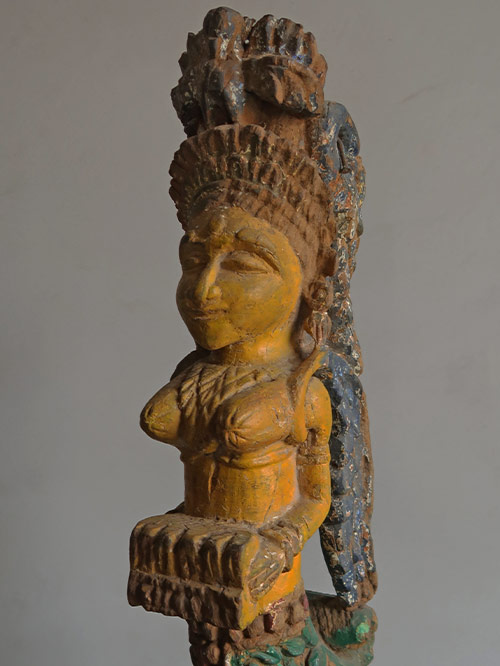
Patan (Gujarat)
Wood, polychromed
A decorative winged musician bracket, the figure who is crowned holds a percussion instrument. She wears a patterned blouse and a pleated skirt.
The ancestral occupation of the Hindu Suthar community, the craft of wood carving was practiced in several districts of Gujarat including Patan, Kadi, Ahmedabad and Nadiad, although the legacy of exquisite wood carving seen in the traditional havelis, mansions, is evident in all the districts of Gujarat. Patan district is renowned for the intricately carved Bohra haveli or mansions at Siddhpur; these structures are characterised by their eclectic use of geometric or floral patterns as well as motifs inspired by European and West Asian decorative elements on the woodwork of the balconies and ceilings.The wooden architecture of Ahmedabad on the other hand, acquires its distinctive aesthetic through the use of patterns borrowed from block printing and textiles.
Size (cms): 64(H) x 14(W) x 21(D)
Size (inches): 25(H) x 5.5(W) x 8.5(D)
-
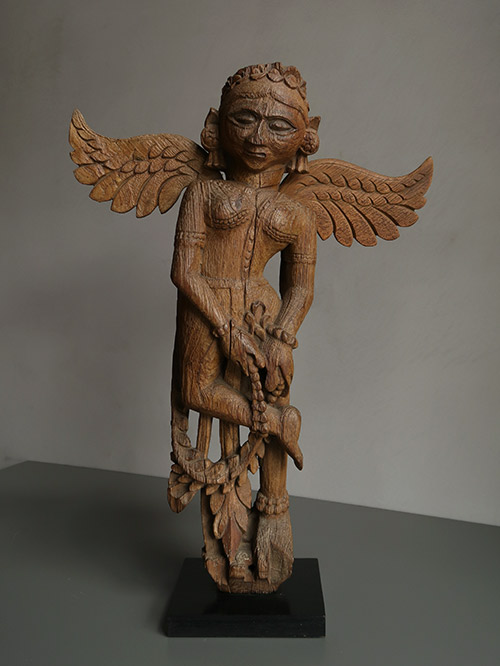
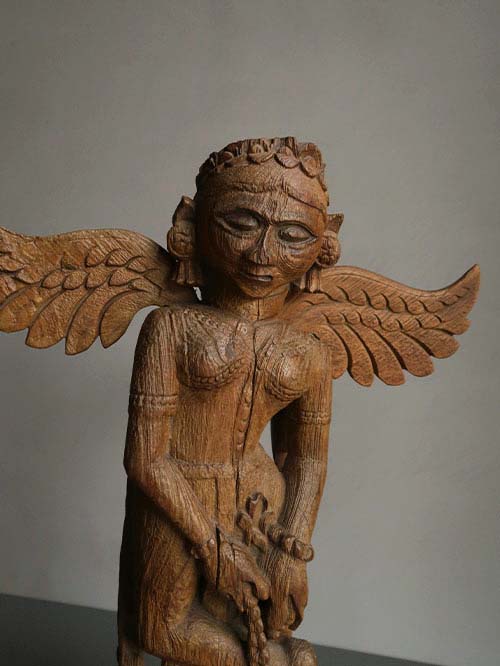
Patan (Gujarat)
Wood
An attractive wooden winged apsara bracket. The crowned figure has patterned wings and holds a long garland which is looped around her leg.
The ancestral occupation of the Hindu Suthar community, the craft of wood carving was practiced in several districts of Gujarat including Patan, Kadi, Ahmedabad and Nadiad, although the legacy of exquisite wood carving seen in the traditional havelis, mansions, is evident in all the districts of Gujarat. Patan district is renowned for the intricately carved Bohra haveli or mansions at Siddhpur; these structures are characterised by their eclectic use of geometric or floral patterns as well as motifs inspired by European and West Asian decorative elements on the woodwork of the balconies and ceilings.The wooden architecture of Ahmedabad on the other hand, acquires its distinctive aesthetic through the use of patterns borrowed from block printing and textiles.
Size (cms): 77(H) x 55(W) x 18(D)
Size (inches): 30.5(H) x 21.5(W) x 7(D)
-
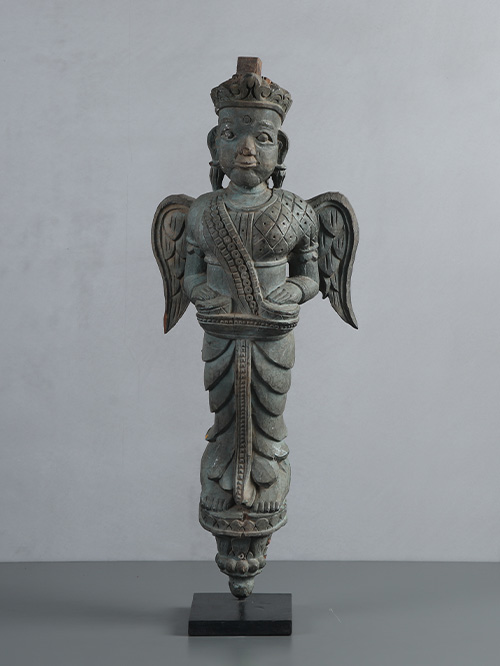

Patan (Gujarat)
Wood, polychromed
A fine figure of a winged angel, crowned, holding a pair of small cymbals. She wears a patterned blouse and a pleated skirt and stands on a lotus shaped base.
The ancestral occupation of the Hindu Suthar community, the craft of wood carving was practiced in several districts of Gujarat including Patan, Kadi, Ahmedabad and Nadiad, although the legacy of exquisite wood carving seen in the traditional havelis, mansions, is evident in all the districts of Gujarat. Patan district is renowned for the intricately carved Bohra haveli or mansions at Siddhpur; these structures are characterised by their eclectic use of geometric or floral patterns as well as motifs inspired by European and West Asian decorative elements on the woodwork of the balconies and ceilings.The wooden architecture of Ahmedabad on the other hand, acquires its distinctive aesthetic through the use of patterns borrowed from block printing and textiles.
Size including the stand (cms): 80 (H) x 28 (W) x 19 (D)
Size including the stand (inches): 31.5 (H) x 11 (W) x 7.5 (D)
-
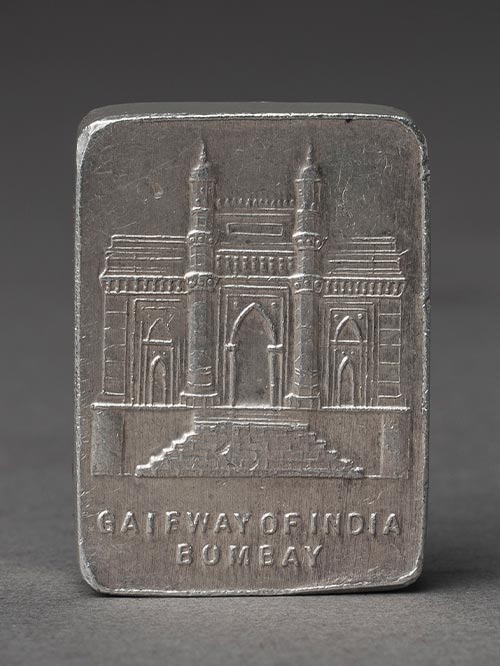
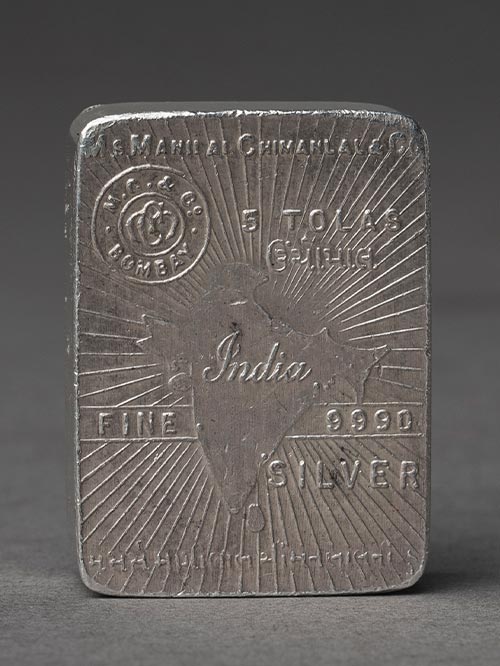
Manilal Chimanlal & Co., Bombay
Silver, 5 Tolas
This rare rectangular silver bar, dating from the late 1950s to early 1960s, depicts a view of the Gateway of India with an embossed caption on one side. On the reverse, there is a map of undivided India, accompanied by details including its weight (5 tolas) and maker’s mark. The term ‘tola’ denotes a unit of mass commonly used in South Asia, with one tola equivalent to 11.66 grams. Therefore, this bar weighs 58.3 grams. It’s noteworthy that the majority of such bars would have been melted down by the Indian government and recast.
Size (cms): 3(H) x 2(W) x 1(D)
Size (inches): 1(H) x 1(W) x 0.5(D)
-
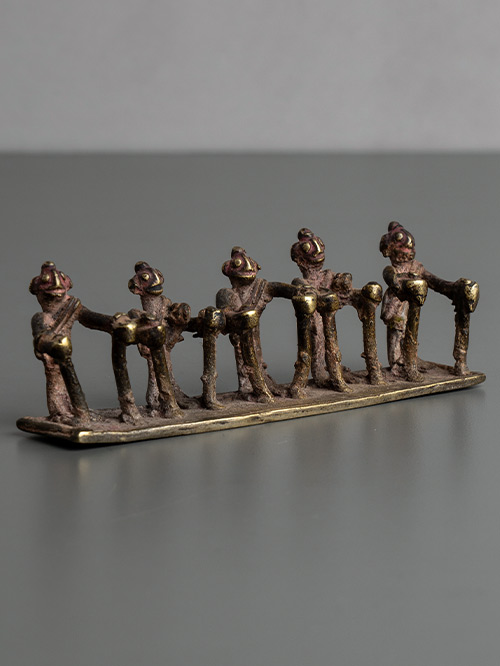
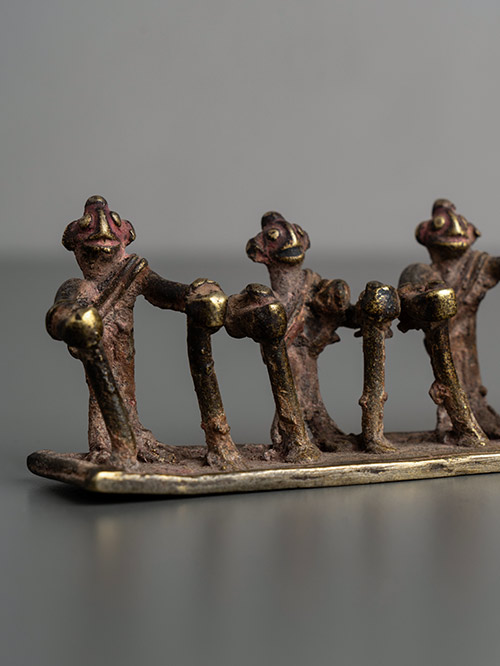
Maharashtra
Brass alloy
This folk bronze depicts a group of munjas (spirits) represented as five men, each holding a pair of sticks and adorned with a yajnopavita (sacred thread). These figures symbolise young men who tragically passed away at the age when they had just begun their studies. To honour their memory and appease their spirits, such figurines are placed on household altars. Through ritual ablution and ceremonies, these ghosts are believed to be transformed into pitra (protective ancestors) who safeguard the family.
Size (cms): 5(H) x 14.5(W) x 3(D)
Size (inches): 2(H) x 5.5(W) x 1(D)
-
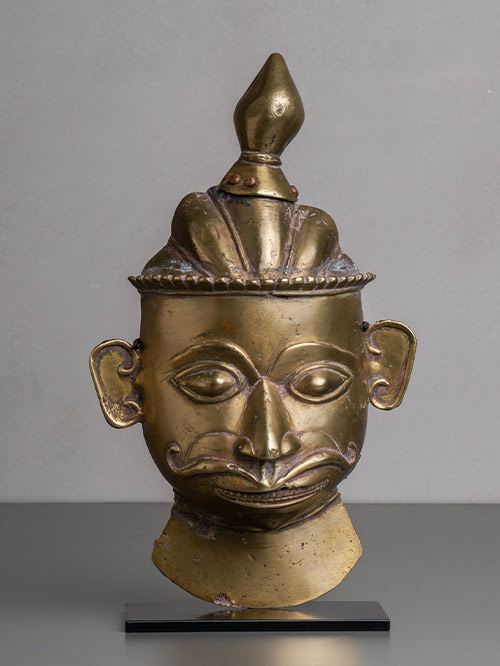
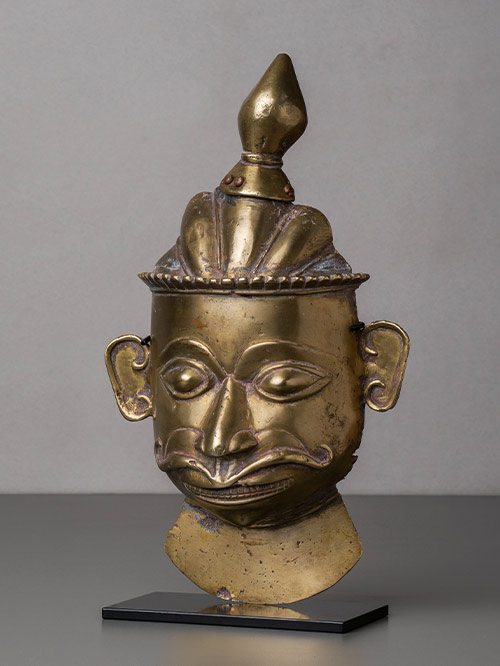
Karnataka (South India)
brass
A striking Hanuman face with a protruding mouth and nose, curving moustache, bulging eyes and forehead tilaka. He wears a necklace and a rimmed and pointed crown.
Mukhavata or facial masks are two-dimensional metal castings of the crowned or turbaned heads of various deities, mostly manifestations of Shiva and Parvati. Included in this group are Khandoba, Mallanna, Gauri and their regional variants who are worshipped under different names.
The story of Hanuman is found in the Ramayana where he is the ubiquitous servant, the epitome of devoted service and loyalty. His search for the heroine Sita, captured by Ravana, illustrates his superhuman powers and zealous performance of the tasks that were given to him.
Size (cms): 32(H) x 19(W) x 11(D)
Size (inches): 12.5(H) x 7.5(W) x 4.5(D)
-
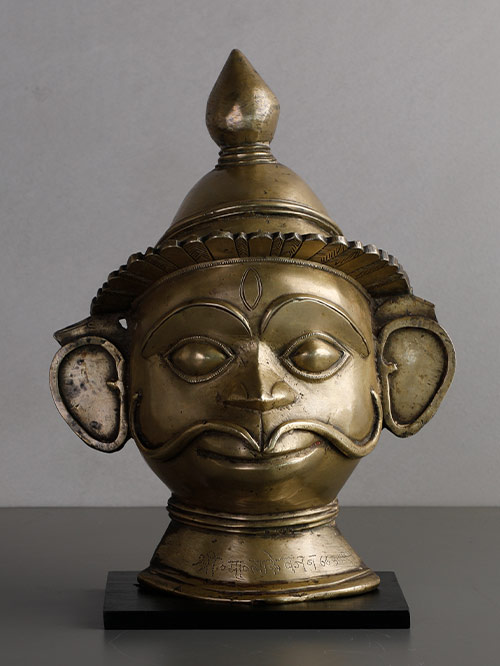
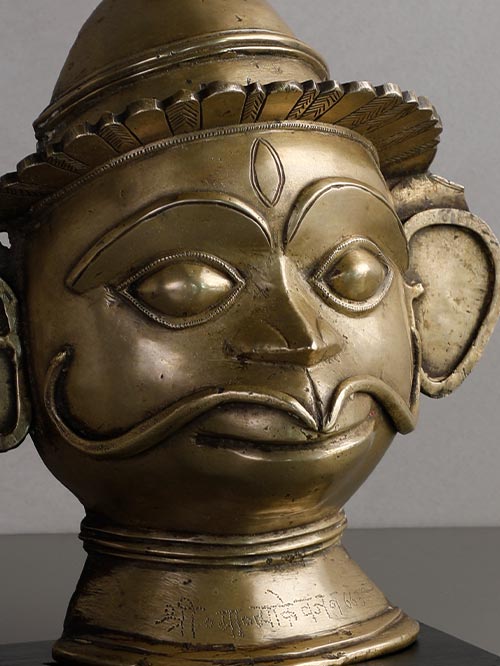
Karnataka (South India)
brass alloy
A striking Hanuman face with a protruding mouth and nose, curving moustache, bulging eyes and forehead tilaka. He wears a necklace and a rimmed and pointed crown.
Mukhavata or facial masks are two-dimensional metal castings of the crowned or turbaned heads of various deities, mostly manifestations of Shiva and Parvati. Included in this group are Khandoba, Mallanna, Gauri and Hanuman and their regional variants who are worshipped under different names.
Hindu devotees believe that when an icon is consecrated and its eyes anointed by the priest, the figure becomes a living god. In household shrines in Maharastra and Karnataka, the deity was considered a privileged house guest and treated accordingly. Images of the god were bathed, clothed, bejeweled and nourished in preparation for puja and darshan. Often elaborate turbans were placed on the head of the mukha-vata and bound by the finest cloths usually in the auspicious deep red colour. In some cases the masks were mounted on a wooden framework and covered with cloths. Sometimes separate metal cast arms and legs were attached to the figure, thus providing a more realistic depiction of the deity.
Size (cms): 35.5(H) x 26(W) x 11.5(D)
Size (inches): 14(H) x 10(W) x 4.5(D)
-
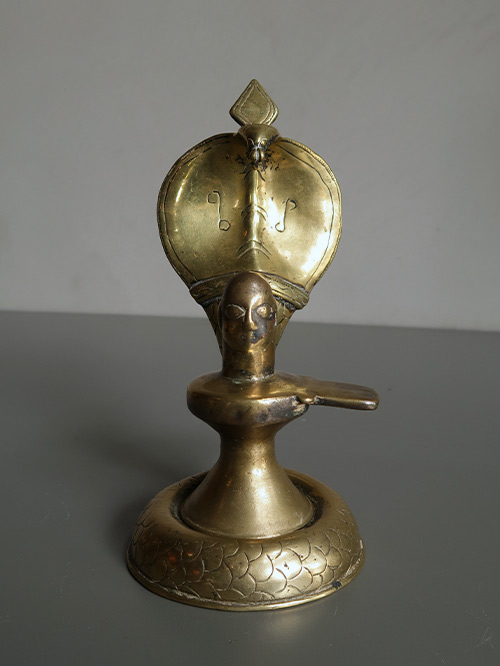
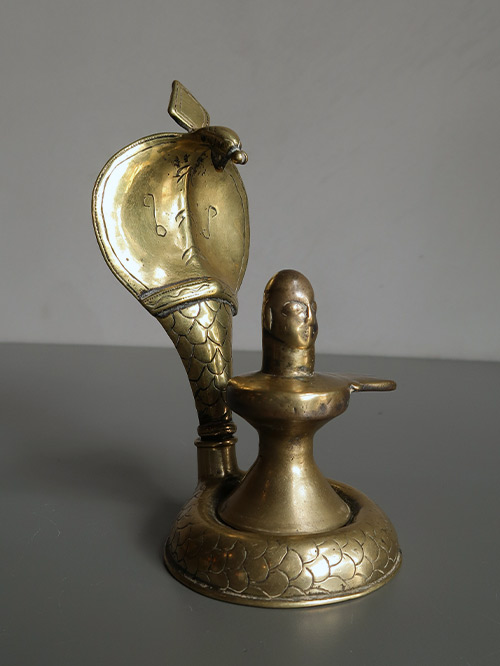
Karnataka (South India)
brass
A finely cast lingam resting on the patterned coils of the serpent Vasuki which forms a canopy overhead.
The Lingam is an abstract or aniconic representation of the Hindu deity Shiva in Shaivism. Lingams are shaped like a pillar with a round top and were made of stone, wood or metal.Eventually, during the Kushan period (1st century to 3rd century CE) in north India, human faces came to be added to the lingams, hence the name mukhalinga. This object marks the presence of the invisible transcendental reality of Shiva, the Hindu god of destruction.
Size (cms): 19(H) x 6.5(W) x 9(D)
Size (inches): 7.5(H) x 2.5(W) x 3.5(D)
-
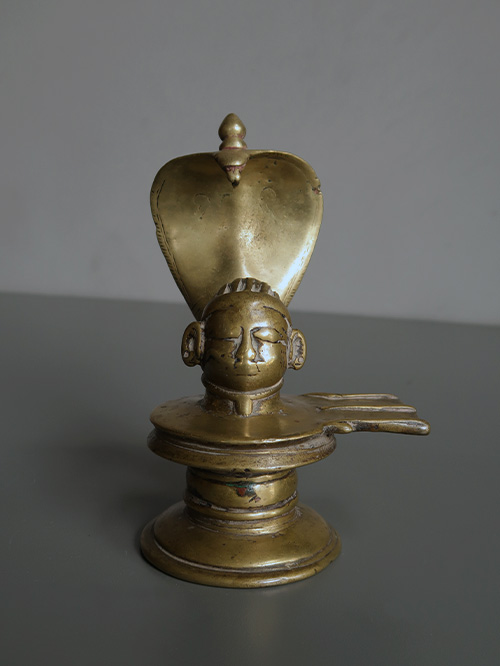

Karnataka (South India)
brass
A finely cast Mukha lingam with a serpent canopy that extends overhead.
The Lingam is an abstract or aniconic representation of the Hindu deity Shiva in Shaivism. Lingams are shaped like a pillar with a round top and were made of stone, wood or metal.Eventually, during the Kushan period (1st century to 3rd century CE) in north India, human faces came to be added to the lingams, hence the name mukhalinga. This object marks the presence of the invisible transcendental reality of Shiva, the Hindu god of destruction.
Size (cms): 16(H) x 10(W) x 9(D)
Size (inches): 6.5(H) x 4(W) x 3.5(D)
-


Karnataka (South India)
brass
Shiva is one of the three principal deities of Hinduism. He is labelled the ‘destroyer’ with the Trimurti, Hinduism’s trinity which includes Brahma and Vishnu. While sometimes depicted iconically, he is usually worshipped in the aniconic from of a lingam. The lingam is shaped like a pillar with a round top and can be made of stone, wood or metal. Mukha-linga signifies a visage or face on a metallic, cylindrical casting used to cover a stone lingam. The cover is thought to protect the viewer from the harm that could occur on visualization of the linga, especially one with eyes painted on its surface, which is believed to energize the figure. The metallic visage iconically depicts Shiva, wearing his characteristic moustache, earrings and matted hair.
Size (cms): 14(H) x 9(W) x 8(D)
Size (inches): 5.5(H) x 3.5(W) x 3.2(D)
-
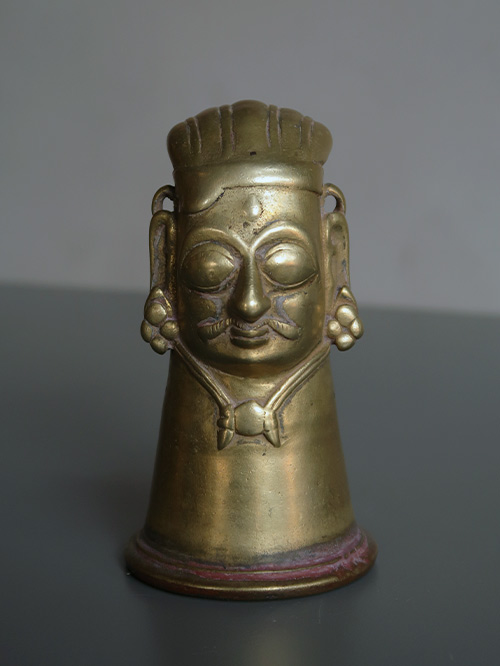
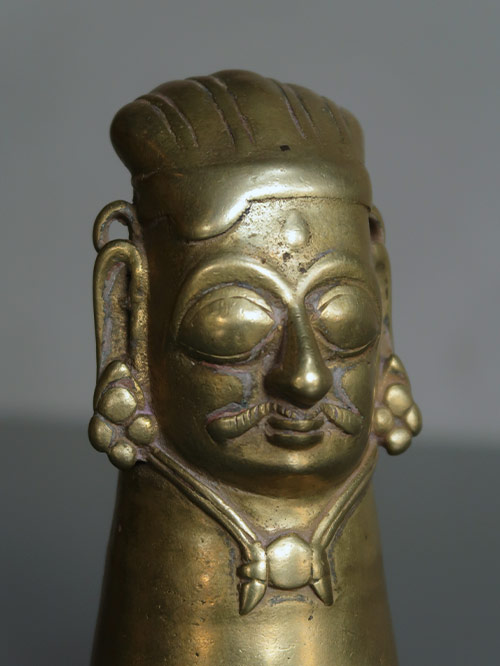
Karnataka (South India)
brass
Shiva is one of the three principal deities of Hinduism. He is labelled the ‘destroyer’ with the Trimurti, Hinduism’s trinity which includes Brahma and Vishnu. While sometimes depicted iconically, he is usually worshipped in the aniconic from of a lingam. The lingam is shaped like a pillar with a round top and can be made of stone, wood or metal. Mukha-linga signifies a visage or face on a metallic, cylindrical casting used to cover a stone lingam. The cover is thought to protect the viewer from the harm that could occur on visualization of the linga, especially one with eyes painted on its surface, which is believed to energize the figure. The metallic visage iconically depicts Shiva, wearing his characteristic moustache, earrings and matted hair.
Size (cms): 14.5(H) x 7.7(Diam)
Size (inches): 5.5(H) x 3(Diam)
-
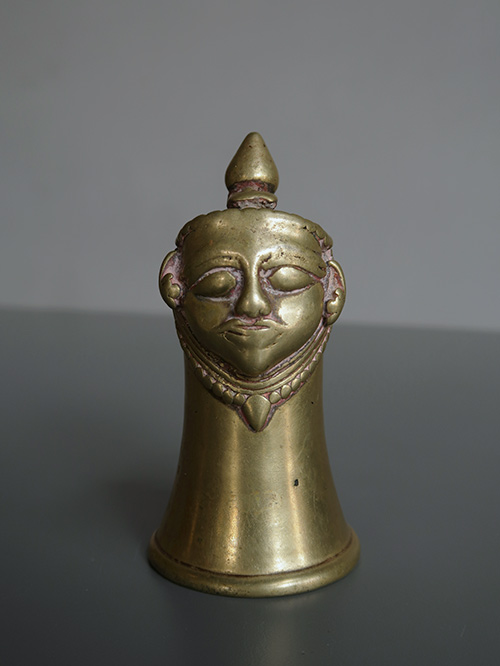

Karnataka (South India)
brass
Shiva is one of the three principal deities of Hinduism. He is labelled the ‘destroyer’ with the Trimurti, Hinduism’s trinity which includes Brahma and Vishnu. While sometimes depicted iconically, he is usually worshipped in the aniconic from of a lingam. The lingam is shaped like a pillar with a round top and can be made of stone, wood or metal. Mukha-linga signifies a visage or face on a metallic, cylindrical casting used to cover a stone lingam. The cover is thought to protect the viewer from the harm that could occur on visualization of the linga, especially one with eyes painted on its surface, which is believed to energize the figure. The metallic visage iconically depicts Shiva, wearing his characteristic moustache, earrings and matted hair.
Size (cms): 12.5(H) x 6.3(Diam)
Size (inches): 5(H) x 2.5(Diam)
-
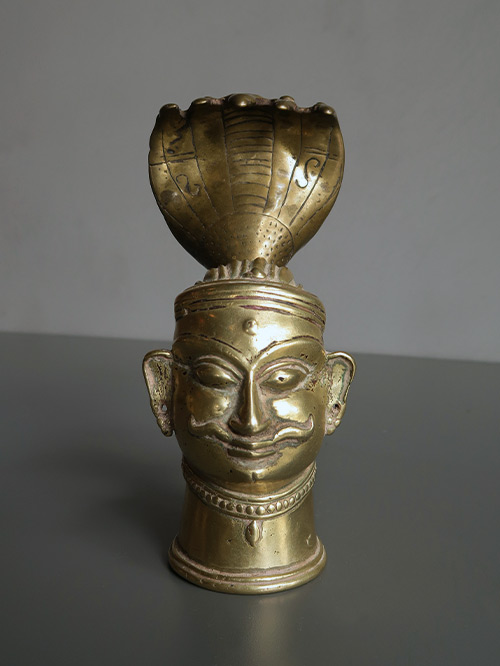
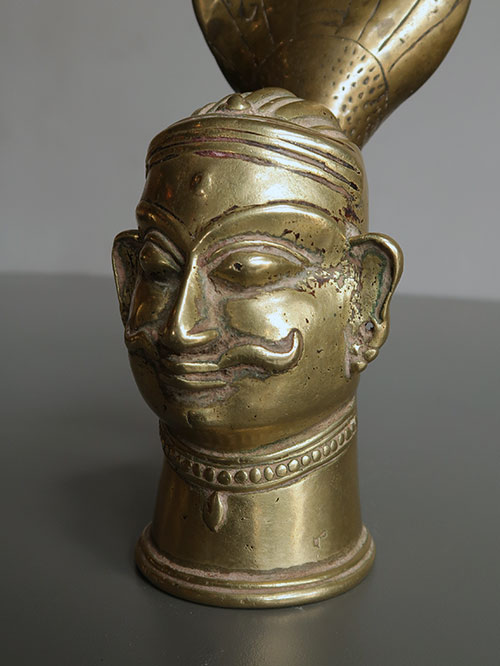
Karnataka (South India)
brass alloy
A finely cast Mukhalingam with a five-headed serpent canopy that extends over the head of the moustached god. Shiva wears a jewelled necklace, a decorated turban and his third eye is prominently displayed on his forehead.
Shiva is one of the three principal deities of Hinduism. He is labelled the ‘destroyer’ with the Trimurti, Hinduism’s trinity which includes Brahma and Vishnu. While sometimes depicted iconically, he is usually worshipped in the aniconic from of a lingam. The lingam is shaped like a pillar with a round top and can be made of stone, wood or metal. Mukhalinga signifies a visage or face on a metallic, cylindrical casting used to cover a stone lingam. The cover is thought to protect the viewer from the harm that could occur on visualization of the linga, especially one with eyes painted on its surface, which is believed to energize the figure. The metallic visage iconically depicts Shiva, wearing his characteristic moustache, earrings and matted hair.
Size (cms): 20(H) x 9(W) x 10(D)
Size (inches): 8(H) x 3.5(W) x 4(D)

































